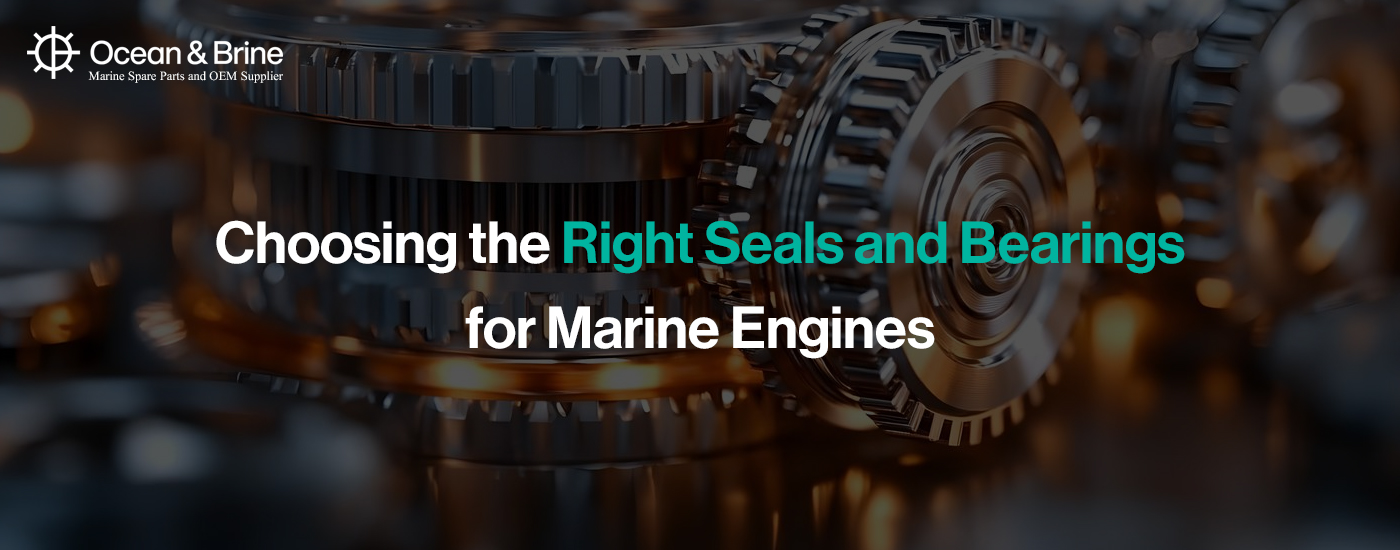Ensure peak performance and prevent costly failures at sea by choosing the right seals and bearings for your marine engines.
Marine engines operate under some of the harshest and most demanding conditions. From high temperatures and pressures to constant vibration and exposure to saltwater, the components within must endure significant stress. Among the most critical of these components are seals and bearings, which are small but vital parts that protect engine integrity, ensure smooth operation, and extend service life.
Choosing the right seals and bearings is not just a technical decision but a strategic one that directly impacts vessel performance, safety, and operating costs.
WhySeals and Bearings Matter
- Seals are responsible for preventing leaks of oil, fuel, or coolant and for keeping contaminants like seawater or debris from entering the engine systems
- Bearings reduce friction between moving parts, support rotating shafts, and ensure smooth motion and alignment
If either of these fails, the consequences can include overheating, increased wear, reduced efficiency, and in extreme cases, total engine breakdown.
Types of Seals for Marine Engines
Different seal types are suited for different applications within marine engines. Key types include:
- Radial lip sealsare used for rotating shafts to retain oil and exclude water or dirt
- Mechanical face seals are ideal for high-pressure or submerged applications such as propeller shafts.
- O-rings and gaskets are common in static applications, used for sealing joints between non-moving parts
- Labyrinth Seals are used for high-speed shafts where minimal leakage is acceptable, but minimal friction is critical
Material Considerations:
- Corrosion-resistant materials like Viton, PTFE, or nitrile rubber, depending on the temperature range and exposure
- Durable under pressure, friction and to temperature fluctuations
- Chemically stable (resistant to fuel, oil, water, etc.)
- UV and ozone resistant (for exposed parts)
Types of Bearings for Marine Engines
Selecting the right bearing depends on load, speed, and alignment conditions:
- Journal bearings (Sleeve Bearings) are used for high-load, low-speed applications like crankshafts
- Ball bearings are ideal for lighter loads and higher speeds, often found in pumps and auxiliary systems
- Roller bearings can handle higher radial loads, suitable for transmission and propulsion systems.
- Thrust bearings are designed to handle axial loads in propulsion systems and vertical shafts
Material considerations:
- Bearings should be made of stainless steel, bronze, or special alloys because these are resistant to corrosion and fatigue
- Durable under continuous load and motion, and reduces energy loss and surface damage
- Should support vessel-specific loads and shocks, especially for high-speed, water-lubricated applications
- Must perform under varying temperatures without deformation, maintaining shape in wet, hot, or pressurized conditions
- Should allow efficient fitting and replacement while operating noiselessly and smoothly
Choose Marine Seals and Bearings by taking into consideration the following factors
- Operating Environment: Temperature extremes, saltwater exposure, and contaminants influence material and design selection.
- Load and Speed Requirements: High-speed shafts need low-friction seals and precision bearings, while high-load areas demand robust, wear-resistant materials.
- Maintenance Schedule: Choose components that align with your vessel’s maintenance intervals to avoid unnecessary downtime.
- OEM vs Aftermarket: OEM parts guarantee compatibility and certification, while high-quality aftermarket options can offer cost savings if sourced responsibly.
- Regulatory Compliance: Ensure all parts meet SOLAS, IMO, and classification society standards relevant to your vessel
The right seals and bearings are essential for keeping marine engines running safely and efficiently. Whether you are maintaining a coastal tugboat or an ocean-crossing cargo ship, the selection of these components should be based on careful evaluation of engine demands, environmental conditions, and compliance requirements.
Ocean and Brine (marine spare parts suppliers) offers a wide range of marine-grade seals and bearings tailored for various engine models and vessel types, backed by technical support and global delivery.
